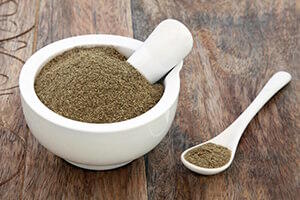06-07-2019
Ayurvedic medicine: the multiple benefits of gymnema sylvestre
 If you haven’t yet come across the medicinal plant gymnema (Gymnema sylvestris), you may be surprised by just how many health benefits it offers. Originating from Asia, this perennial climber has been used therapeutically for thousands of years. In Ayurveda, it is known as gurmar, a Hindi name related to its traditional use for diabetes. Along with a blood sugar-lowering effect, confirmed by several scientific studies, gymnema sylvestre has demonstrated a number of other properties over the last few years. Drawing on an article published in the journal BioMed Research International1, we explore below the benefits of this Ayurvedic plant.
If you haven’t yet come across the medicinal plant gymnema (Gymnema sylvestris), you may be surprised by just how many health benefits it offers. Originating from Asia, this perennial climber has been used therapeutically for thousands of years. In Ayurveda, it is known as gurmar, a Hindi name related to its traditional use for diabetes. Along with a blood sugar-lowering effect, confirmed by several scientific studies, gymnema sylvestre has demonstrated a number of other properties over the last few years. Drawing on an article published in the journal BioMed Research International1, we explore below the benefits of this Ayurvedic plant.
Gymnema sylvestre’s hypoglycaemic activity
Beneficial effects for blood sugar control
Gymnema sylvestris) is an Ayurvedic plant known to act on the body’s glucose levels. In Ayurveda texts, it is described as a ‘destroyer of sugar’. Though its mechanisms of action are not yet fully understood, recent studies have identified several compounds with hypoglycaemic properties such as gymnemic acids and gurmarin. These active principles have been shown to combat sugar cravings by attaching themselves to specific receptors on the taste buds. Similarly, they bind to receptors in the gut, thus reducing the body’s absorption of sugar. Other studies suggest that gymnemic acids imitate or stimulate the activity of incretins, gastrointestinal hormones involved in insulin secretion. Confirmed efficacy of Gymnema sylvestris against hyperglycaemia
Gymnema sylvestris has been the subject of several studies investigating its hypoglycaemic activity. One group of researchers focused in particular on the efficacy of gymnemic acids in regulating blood sugar. Their study showed that these natural active principles reduced blood glucose by up to 60% in the six hours after ingestion. With this considerable hypoglycaemic activity, gymnema sylvestre has attracted scientific interest for its potential to combat hyperglycaemia, a process involved in a number of metabolic disorders including diabetes and obesity. Some studies also suggest that gymnema may represent a significant aid to weight loss. Therapeutic benefits against diabetes and obesity
A number of animal studies have been conducted to evaluate the efficacy of this Ayurvedic plant for addressing metabolic disorders. In one such study, scientists monitored the effects of supplementation with an extract of Gymnema sylvestris in obese rats. They observed improvements in several biological markers including levels of transaminase enzymes such as alanine aminotransferase and glutathione peroxidase. Involved in gluconeogenesis and ketogenesis, these are prevalent in diabetes. By reducing levels of these two enzymes, gymnema sylvestre may therefore help combat diabetes.
Lipid-lowering activity of Gymnema sylvestris
Beneficial effect against ‘bad’ cholesterol
In addition to its hypoglycaemic properties, gymnema sylvestre has been widely studied for its lipid-lowering properties, particularly its ability to lower cholesterol. For example, scientists evaluated the effects of supplementation with an extract of Gymnema sylvestris
Preventive role against hyperlipidaemia and coronary diseases
The discovery of gymnema’s lipid- and cholesterol-lowering properties opens up promising new prospects for the prevention and treatment of several diseases. By reducing lipid levels, this Ayurvedic plant may help fight hyperlipidaemia, a process involved in coronary diseases. According to studies on this subject, Gymnema sylvestris may, in particular, prevent excess lipids and cholesterol deposits in the coronary arteries. Additional studies are underway to develop these findings.
Multiple protective effects being studied
While it is gymnema sylvestre’s hypoglycaemic and lipid-lowering properties which are currently the most widely-documented, other benefits are also being investigated. Some scientists believe it has anti-microbial and anti-bacterial activity which is effective against a number of pathogenic strains including Staphylococcus aureus, Escherichia coli and Bacillus subtilis. Studies also suggest this Ayurvedic plant offers cytotoxic effects which could help combat the development of cancer cells. Gymnema sylvestris appears to have anti-inflammatory properties too, potentially as a result of its tannin and saponin content. In addition, it may have an immune-modulating effect, enabling it to regulate immune system activity and thus help boost the body’s immune defences in general. That is why a number of studies are examining gymnema sylvestre’s therapeutic potential. It is also being investigated in relation to the prevention and treatment of various health problems such as arthritis, Parkinson’s disease, dental caries and digestive disorders.
While the plant Gymnema sylvestris has so far been primarily associated with its hypoglycaemic effects in regulating blood glucose levels, it is now clear that its therapeutic potential extends well beyond this. As well as combatting hyperglycaemia, it has been shown to be beneficial for hyperlipidaemia and hypercholesterolaemia. Other research has shown it may help boost the body’s natural defences. Very popular in naturopathy, this Ayurvedic plant is now available as a supplement in the form of an extract of Gymnema sylvestris standardised to contain 75% gymnemic acids.
> Source :
1. Pragya Tiwari, et al., Phytochemical and Pharmacological Properties of Gymnema sylvestre: An Important Medicinal Plant, Biomed Res Int. 2014; 2014: 830285.
Order the nutrient mentioned in this article

Standardised extract 75% gymnemic acids, improves pancreas function
www.supersmart.comFurther reading
05-08-2016
Here’s a simple way to burn calories without having to undertake strenuous exercise - or even move an inch.Scientists have discovered that the body uses...
Read more10-10-2016
In India, turmeric is used to treat a wide variety of ailments including gastrointestinal problems, inflammation, headaches, infections and colds. It is turmeric’s curcuminoid content,...
Read more10-05-2016
If you’ve consistently failed in your attempts to lose weight, it could be you’re missing a key ingredient. That ingredient is a healthy gut flora....
Read more© 1997-2025 Fondation pour le Libre Choix
All rights reserved
All rights reserved
Free
Thank you for visiting our site. Before you go
REGISTER WITHClub SuperSmart
And take advantage
of exclusive benefits:
of exclusive benefits:
- Free: our weekly science-based newsletter "Nutranews"
- Special offers for club members only

















